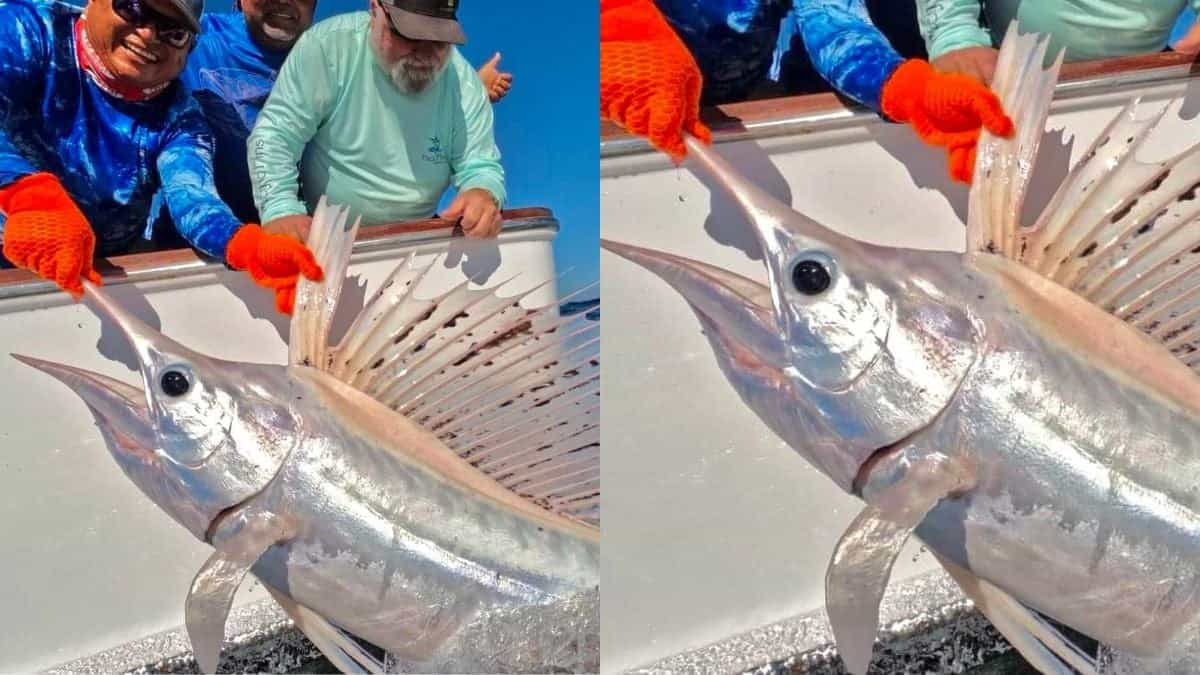Show table of content Hide table of content
In a remarkable fishing expedition off the coast of Guatemala, a group of fishermen recently made an incredible discovery. While sailing in the Pacific Ocean, they captured what experts are calling a “one in a million” white sailfish, a spectacular marine creature that has captivated the attention of marine enthusiasts worldwide. This extraordinary catch, characterized by its unusual white coloration, represents one of nature’s rarest genetic phenomena.
Rare white sailfish: an extraordinary marine phenomenon
The striking white sailfish was caught last week by Paul Renfro and his fishing crew aboard the vessel Libertad. Operating excursions for guests of Pacific Fins Resort in Iztapa, southern Guatemala, the team couldn’t believe their eyes when they pulled this magnificent creature from the depths. Unlike the typical blue-gray coloration of sailfish, this specimen displayed an almost ethereal white appearance.
Marine biologists clarify that this fish isn’t albino as many initially suspected. Rather, it exhibits a condition called leucism, which causes partial loss of pigmentation. Unlike albinism, leucism doesn’t affect eye color, and this sailfish maintained its normal eye coloration instead of the red eyes typical of albino animals. This genetic variation occurs extremely rarely in wild populations, making this discovery particularly significant.
Fishing Two police officers rescue a 5,000-pound fish—the heaviest in the world—stranded on a beach.
Such rare genetic variations can occur in many species, not just marine life. For instance, certain species of crocodiles trapped in caves for thousands of years have evolved unique traits due to their isolated environments, demonstrating how animals adapt to their surroundings through genetic changes.
The Pacific Fins Resort shared images of this remarkable catch on social media, aptly dubbing it a “unicorn swordfish” or “white sailfish” and emphasizing its one-in-a-million rarity. The photographs quickly gained attention online, with many marine enthusiasts marveling at the fish’s otherworldly appearance that seemed more at home in fantasy than reality.
Guatemala’s reputation as a sailfish sanctuary
Guatemala has earned its nickname as “the fisherman’s paradise” for good reason. The Pacific waters off its coast provide ideal conditions for various marine species, particularly sailfish. These waters consistently rank among the world’s premier destinations for sailfish encounters, drawing fishing enthusiasts from across the globe hoping to experience the thrill of catching one of these magnificent creatures.
According to the Pacific Fins Resort, the last documented capture of a white sailfish in Guatemalan waters occurred in 2018, underscoring the exceptional nature of this recent discovery. Standard sailfish are relatively common in these waters, but specimens with leucism remain extraordinarily rare, appearing perhaps once every several years.
News This TikToker buys a used van and realizes it has a hidden surveillance device.
Guatemala’s reputation for maritime conservation matches its fame for exceptional fishing. Many fishing operations in the region, including those run by the Pacific Fins Resort, practice catch-and-release protocols to ensure the sustainability of marine populations. This reflects a growing awareness of the importance of preserving unusual specimens like this white sailfish.
The unusual white sailfish joins other remarkable wildlife stories that capture public imagination. From unusual animal smuggling attempts at airports to extraordinary marine discoveries, these encounters remind us of nature’s endless capacity to surprise.
Understanding the indo-pacific sailfish
The Indo-Pacific sailfish (Istiophorus platypterus) remains one of the ocean’s most recognizable and impressive residents. Characterized by its distinctive sail-like dorsal fin and elongated upper jaw, this species can reach speeds of up to 68 miles per hour, making it reportedly the fastest fish in the sea. This remarkable velocity allows it to slash through schools of smaller fish with its bill, stunning prey before consuming them.
Adult sailfish typically grow to 10 feet in length and can weigh between 120-220 pounds. Their standard coloration includes a deep blue-black along the dorsal area, fading to silver-white on the belly – making this all-white specimen particularly striking by comparison. Their magnificent dorsal fin, which they can raise and lower at will, serves multiple purposes from temperature regulation to prey intimidation.
These magnificent creatures typically inhabit tropical and temperate waters worldwide, with particular concentrations in the Pacific and Indian Oceans. Their populations face various threats, including commercial fishing operations and habitat degradation, making conservation efforts increasingly important.
Like many marine species, sailfish demonstrate the remarkable diversity of ocean ecosystems. Animals have incredible capacities for adaptation and survival, whether through speed and agility like the sailfish or through emotional bonding as seen in stories of pets reuniting with owners after years of separation.
The fate of the white sailfish
For those concerned about the welfare of this exceptional creature, there’s good news. Following its capture and documentation, the fishing crew promptly returned the white sailfish to the ocean. This practice aligns with sustainable fishing ethics and helps preserve genetic diversity within marine populations. The crew recognized the significance of their find and prioritized the animal’s survival over keeping it as a trophy.
Catch-and-release fishing has become standard practice for recreational sailfish expeditions in Guatemala. This approach allows fishermen to experience the thrill of the catch while minimizing impact on fish populations. The white sailfish, despite its brief encounter with humans, returned to its natural habitat with minimal stress or injury.
News Bat wings after 50? Here’s the most effective exercise, according to a coach.
The discovery serves as a reminder of the wonders that still exist in our oceans and the importance of protecting marine biodiversity. As climate change and overfishing threaten ocean ecosystems worldwide, encounters with rare creatures like this white sailfish emphasize what could be lost without proper conservation measures.
For the fishermen aboard Libertad, this extraordinary encounter represents a once-in-a-lifetime experience – a brief glimpse of one of nature’s rarest marvels before it disappeared back into the vast Pacific, continuing its life as one of the ocean’s most unique inhabitants.


